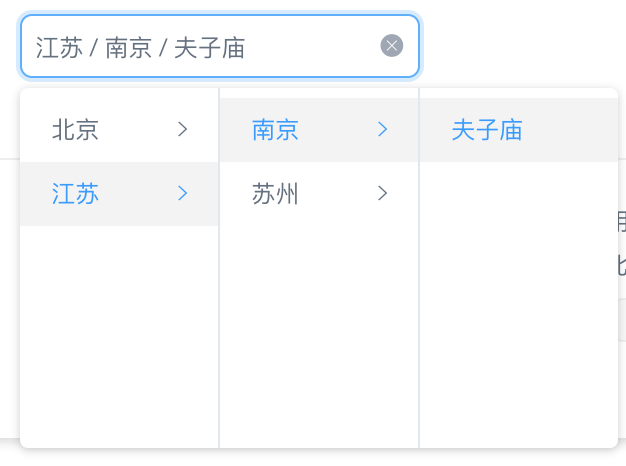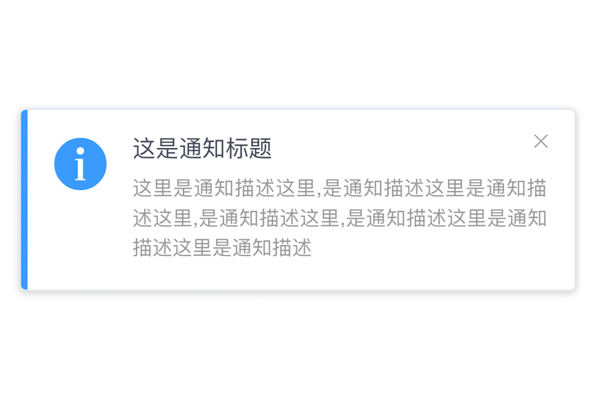Vue中你不知道但却很实用的黑科技
最近数月一直投身于 iView 的开源工作中,完成了大大小小 30 多个 UI 组件,在 Vue 组件化开发中积累了不少经验。其中也有很多带有技巧性和黑科技的组件,这些特性有的是 Vue 文档中提到但却容易被忽略的,有的更是没有写在文档里,今天就说说 Vue 组件的高级玩法。
写在前面
本文所讲内容大多在 iView 项目中使用,大家可以前往关注,并结合源代码来研究其中的奥妙。项目地址: https://github.com/iview/iview
目录
- 递归组件
- 自定义组件使用
v-model - 使用
$compile()在指定上下文中手动编译组件 - 内联模板
inline-template - 隐式创建 Vue 实例
递归组件
递归组件在文档中有介绍,只要给组件指定一个 name 字段,就可以在该组件递归地调用自己,例如:
var iview = Vue.extend({
name: 'iview',
template:
'<div>' +
// 递归地调用它自己
'<iview></iview>' +
'</div>'
})
这种用法在业务中并不常见,在 iView 的级联选择组件中使用了该特性
( https://github.com/iview/iview/tree/master/src/components/cascader )
效果如下图所示:
图中每一列是一个组件( caspanel.vue ),一开始想到用 v-for 来渲染列表,但后面发现扩展性极低,而且随着功能的丰富,实现起来很困难,处理的逻辑很多,于是改写成了递归组件:
<ul v-if="data && data.length" :class="[prefixCls + '-menu']">
<Casitem
v-for="item in data"
:prefix-cls="prefixCls"
:data.sync="item"
:tmp-item="tmpItem"
@click.stop="handleClickItem(item)"
@mouseenter.stop="handleHoverItem(item)"></Casitem>
</ul><Caspanel v-if="sublist && sublist.length" :prefix-cls="prefixCls" :data.sync="sublist" :disabled="disabled" :trigger="trigger" :change-on-select="changeOnSelect"></Caspanel>
props 比较多,可以忽略,但其中关键的两个是 data 和 sublist ,即当前列数据和子集的数据,因为预先不知道有多少下级,所以只需传递下级数据给组件本身,如果为空时,递归就结束了,Vue 这样设计的确很精妙。
注:该方法在 Vue 1.x 和 2.x 中都支持。
自定义组件使用 v-model
我们知道, v-model 是在表单类元素上进行双向绑定时使用的,比如:
<template>
<input type="text" v-model="data">
{{ data }}
</template>
<script>
export default {
data () {
return {
data: ''
}
}
}
</script>
这时 data 就是双向绑定的,输入的内容会实时显示在页面上。在 Vue 1.x 中,自定义组件可以使用 props 的 .sync 双向绑定,比如:
<my-component :data.sync="data"></my-component>
在 Vue 2.x 中,可以直接在自定义组件上使用 v-model 了,比如:
<my-component v-model="data"></my-component>
在组件 my-component 中,通过 this.$emit('input') 就可以改变data的值了。
虽然 Vue 1.x 中无法这样使用,但是如果你的组件的模板外层是 input 、 select 、 textarea 等支持绑定 v-model 特性的元素,也是可以使用的,比如 my-component 的代码是:
<template>
<input type="text">
</template>
那也可以使用上面2.x的写法。
使用 $compile() 在指定上下文中手动编译组件
注:该方法是在 Vue 1.x 中的使用介绍,官方文档并没有给出该方法的任何说明,不可过多依赖此方法。
使用 $compile() 方法,可以在任何一个指定的上下文(Vue实例)上手动编译组件,该方法在 iView 新发布的表格组件 Table 中有使用: https://github.com/iview/iview/tree/master/src/components/table/cell.vue
由于表格的列配置是通过一个 Object 传入 props 的,因此不能像 slot 那样自动编译带有 Vue 代码的部分,因为传入的都是字符串,比如:
{
render (row) {
return `<i-button>${row.name}</i-button>`
}
}
render函数最终返回一个字符串,里面含有一个自定义组件 i-button,如果直接用 {{{ }}} 显示,i-button 是不会被编译的,那为了实现在单元格内支持渲染自定义组件,就用到了 $compile() 方法。
比如我们在组件的父级编译:
// 代码片段
const template = this.render(this.row); // 通过上面的render函数得到字符串
const div = document.createElement('div');
div.innerHTML = template;
this.$parent.$compile(div); // 在父级上下文编译组件
this.$el.appendChild(cell); // 将编译后的html插入当前组件
这样一来, i-button 就被编译了。
在某些时候使用 $compile() 确实能带来益处,不过也会遇到很多问题值得思考:
- 这样编译容易把作用域搞混,所以要知道是在哪个Vue实例上编译的;
- 手动编译后,也需要在合适的时候使用 $destroy() 手动销毁;
- 有时候容易重复编译,所以要记得保存当前编译实例的id,这里可以通过 Vue 组件的 _uid 来唯一标识(每个Vue实例都会有一个递增的id,可以通过 this._uid 获取)
另外,Vue 1.x 文档也有提到另一个 $mount() 方法,可以实现类似的效果,在 Vue 2.x 文档中,有 Vue.compile() 方法,用于在render函数中编译模板字符串,读者可以结合来看。
内联模板 inline-template
内联模板并不是什么新鲜东西,文档中也有说明,只是平时几乎用不到,所以也容易忽略。简短解说,就是把组件的 slot 当做这个组件的模板来使用,这样更为灵活:
<!-- 父组件: -->
<my-component inline-template>
{{ data }}
</my-component>
<!-- 子组件 -->
<script>
export default {
data () {
return {
data: ''
}
}
}
</script>
因为使用了 inline-template 内联模板,所以子组件不需要 <template> 来声明模板,这时它的模板直接是从 slot 来的 {{ data }} ,而这个 data 所在的上下文,是子组件的,并不是父组件的,所以,在使用内联模板时,最容易产生的误区就是混淆作用域。
隐式创建 Vue 实例
在 webpack 中,我们都是用 .vue 单文件的模式来开发,每个文件即一个组件,在需要的地方通过 components: {} 来使用组件。
比如我们需要一个提示框组件,可能会在父级中这样写:
<template>
<Message>这是提示标题</Message>
</template>
<script>
import Message from '../components/message.vue';
export default {
components: { Message }
}
</script>
这样写没有任何问题,但从使用角度想,我们其实并不期望这样来用,反而原生的 window.alert('这是提示标题') 这样使用起来更灵活,那这时很多人可能就用原生 JS 拼字符串写一个函数了,这也没问题,不过如果你的提示框组件比较复杂,而且多处复用,这种方法还是不友好的,体现不到 Vue 的价值。
iView 在开发全局提示组件(Message)、通知提醒组件(Notice)、对话框组件(Modal)时,内部都是使用 Vue 来渲染,但却是 JS 来隐式地创建这些实例,这样我们就可以像 Message.info('标题') 这样使用,但其内部还是通过 Vue 来管理。相关代码地址: https://github.com/iview/iview/tree/master/src/components/base/notification
下面我们来看一下具体实现:  上图是最终效果图,这部分 .vue 代码比较简单,相信大家都能写出这样一个组件来,所以直接说创建实例的部分,先看下核心代码:
上图是最终效果图,这部分 .vue 代码比较简单,相信大家都能写出这样一个组件来,所以直接说创建实例的部分,先看下核心代码:
import Notification from './notification.vue';
import Vue from 'vue';
import { camelcaseToHyphen } from '../../../utils/assist';
Notification.newInstance = properties => {
const _props = properties || {};
let props = '';
Object.keys(_props).forEach(prop => {
props += ' :' + camelcaseToHyphen(prop) + '=' + prop;
});
const div = document.createElement('div');
div.innerHTML = `<notification${props}></notification>`;
document.body.appendChild(div);
const notification = new Vue({
el: div,
data: _props,
components: { Notification }
}).$children[0];
return {
notice (noticeProps) {
notification.add(noticeProps);
},
remove (key) {
notification.close(key);
},
component: notification,
destroy () {
document.body.removeChild(div);
}
}
};
export default Notification;
与上文介绍的 $compile() 不同的是,这种方法是在全局(body)直接使用 new Vue 创建一个 Vue 实例,我们只需要在入口处对外暴露几个 API 即可:
import Notification from '../base/notification';
const prefixCls = 'ivu-message';
const iconPrefixCls = 'ivu-icon';
const prefixKey = 'ivu_message_key_';
let defaultDuration = 1.5;
let top;
let messageInstance;
let key = 1;
const iconTypes = {
'info': 'information-circled',
'success': 'checkmark-circled',
'warning': 'android-alert',
'error': 'close-circled',
'loading': 'load-c'
};
function getMessageInstance () {
messageInstance = messageInstance || Notification.newInstance({
prefixCls: prefixCls,
style: {
top: `${top}px`
}
});
return messageInstance;
}
function notice (content, duration = defaultDuration, type, onClose) {
if (!onClose) {
onClose = function () {
}
}
const iconType = iconTypes[type];
// if loading
const loadCls = type === 'loading' ? ' ivu-load-loop' : '';
let instance = getMessageInstance();
instance.notice({
key: `${prefixKey}${key}`,
duration: duration,
style: {},
transitionName: 'move-up',
content: `
<div class="${prefixCls}-custom-content ${prefixCls}-${type}">
<i class="${iconPrefixCls} ${iconPrefixCls}-${iconType}${loadCls}"></i>
<span>${content}</span>
</div>
`,
onClose: onClose
});
// 用于手动消除
return (function () {
let target = key++;
return function () {
instance.remove(`${prefixKey}${target}`);
}
})();
}
export default {
info (content, duration, onClose) {
return notice(content, duration, 'info', onClose);
},
success (content, duration, onClose) {
return notice(content, duration, 'success', onClose);
},
warning (content, duration, onClose) {
return notice(content, duration, 'warning', onClose);
},
error (content, duration, onClose) {
return notice(content, duration, 'error', onClose);
},
loading (content, duration, onClose) {
return notice(content, duration, 'loading', onClose);
},
config (options) {
if (options.top) {
top = options.top;
}
if (options.duration) {
defaultDuration = options.duration;
}
},
destroy () {
let instance = getMessageInstance();
messageInstance = null;
instance.destroy();
}
}
到这里组件已经可以通过 Message.info() 直接调用了,不过我们还可以在 Vue 上进行扩展: Vue.prototype.$Message = Message;
这样我们可以直接用 this.$Message.info() 来调用,就不用 import Message 了。
后记
Vue 组件开发中有很多有意思的技巧,用好了会减少很多不必要的逻辑,用不好反而还弄巧成拙。在开发一个较复杂的组件时,一定要先对技术方案进行调研和设计,然后再编码。
iView 还有很多开发技巧和有意思的代码,后面有时间我们再继续探讨吧,最近发布的几个版本都有较大的更新,希望大家可以关注和推广 iView :
https://github.com/iview/iview











![[HBLOG]公众号](https://www.liuhaihua.cn/img/qrcode_gzh.jpg)

